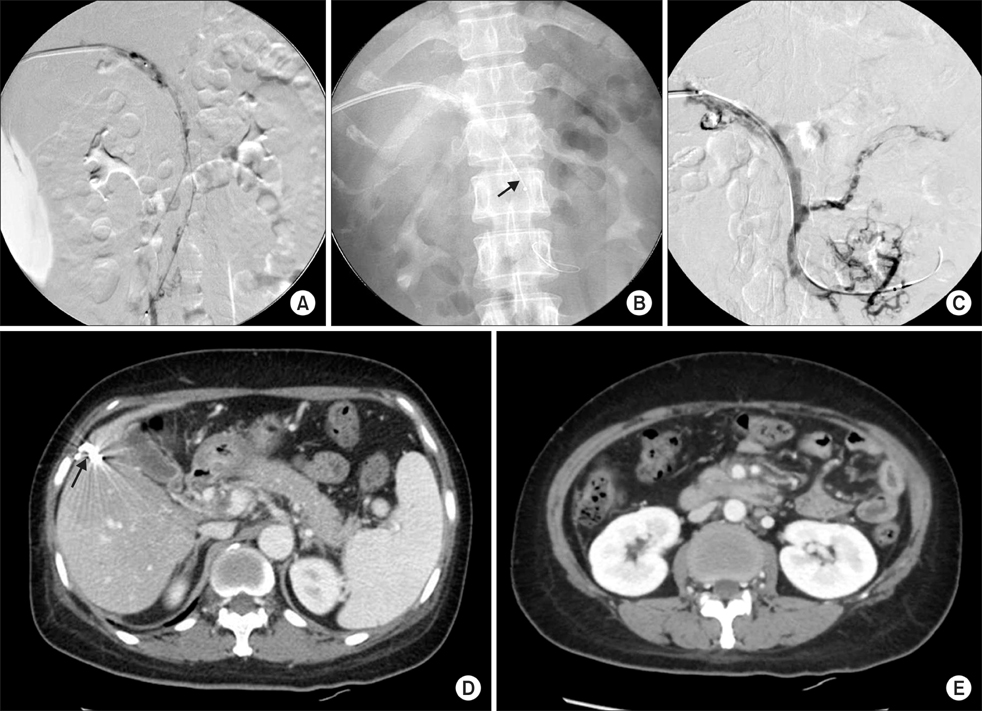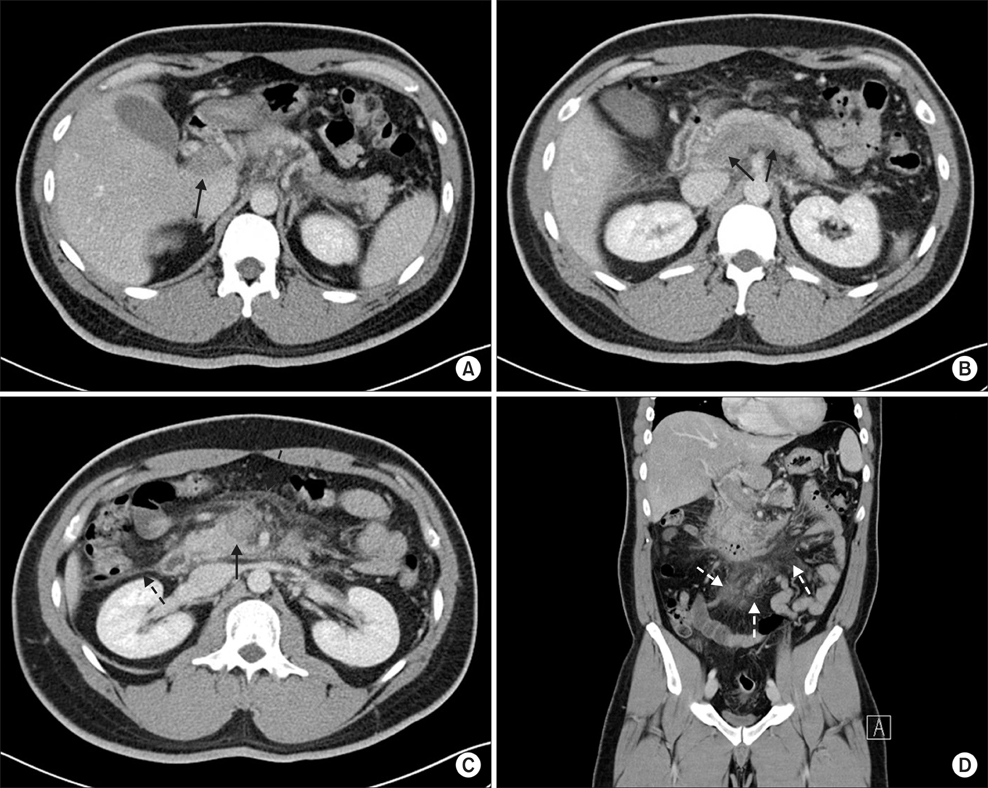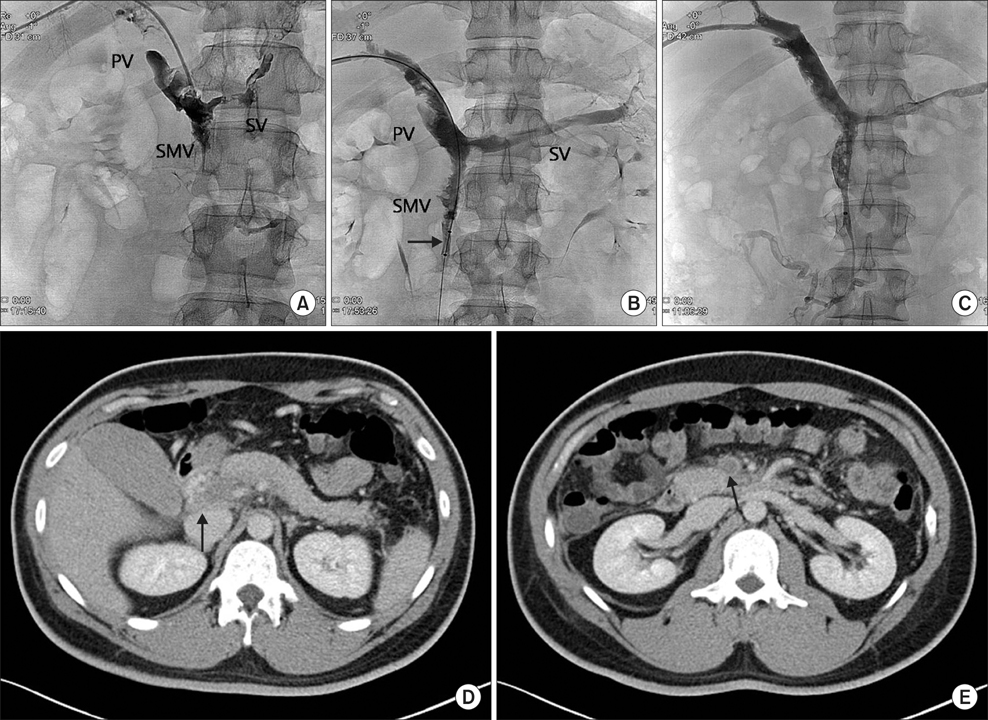Ann Surg Treat Res.
2014 Jun;86(6):334-341. 10.4174/astr.2014.86.6.334.
Mechanical thrombectomy-assisted thrombolysis for acute symptomatic portal and superior mesenteric venous thrombosis
- Affiliations
-
- 1Department of Surgery, The Catholic University of Korea, Seoul St. Mary's Hospital, Seoul, Korea. vascularkim@catholic.ac.kr
- 2Department of Radiology, The Catholic University of Korea, Seoul St. Mary's Hospital, Seoul, Korea.
- 3Department of Surgery, Inha University Hospital, Inha University, Incheon, Korea.
- 4Department of Radiology, Inha University Hospital, Inha University, Incheon, Korea.
- KMID: 2167113
- DOI: http://doi.org/10.4174/astr.2014.86.6.334
Abstract
- Acute portal vein and mesenteric vein thrombosis (PVMVT) can cause acute mesenteric ischemia and be fatal with mortality rate of 37%-76%. Therefore, early diagnosis and prompt venous revascularization are warranted in patients with acute symptomatic PVMVT. Due to advances in catheter-directed treatment, endovascular treatment has been used for revascularization of affected vessels in PVMVT. We report two cases of symptomatic PVMVT treated successfully by transhepatic percutaneous mechanical thrombectomy-assisted thrombolysis.
MeSH Terms
Figure
Reference
-
1. Chen C. Direct thrombolytic therapy in portal and mesenteric vein thrombosis. J Vasc Surg. 2012; 56:1124–1126.2. Lopera JE, Correa G, Brazzini A, Ustunsoz B, Patel S, Janchai A, et al. Percutaneous transhepatic treatment of symptomatic mesenteric venous thrombosis. J Vasc Surg. 2002; 36:1058–1061.3. Zhou W, Choi L, Lin PH, Dardik A, Eraso A, Lumsden AB. Percutaneous transhepatic thrombectomy and pharmacologic thrombolysis of mesenteric venous thrombosis. Vascular. 2007; 15:41–45.4. Kim HS, Patra A, Khan J, Arepally A, Streiff MB. Transhepatic catheter-directed thrombectomy and thrombolysis of acute superior mesenteric venous thrombosis. J Vasc Interv Radiol. 2005; 16:1685–1691.5. Uflacker R. Applications of percutaneous mechanical thrombectomy in transjugular intrahepatic portosystemic shunt and portal vein thrombosis. Tech Vasc Interv Radiol. 2003; 6:59–69.6. Rosen MP, Sheiman R. Transhepatic mechanical thrombectomy followed by infusion of TPA into the superior mesenteric artery to treat acute mesenteric vein thrombosis. J Vasc Interv Radiol. 2000; 11:195–198.7. Wissgott C, Kamusella P, Andresen R. Percutaneous mechanical thrombectomy: advantages and limitations. J Cardiovasc Surg (Torino). 2011; 52:477–484.8. Morgan R, Belli AM. Percutaneous thrombectomy: a review. Eur Radiol. 2002; 12:205–217.9. Sharafuddin MJ, Hicks ME. Current status of percutaneous mechanical thrombectomy. Part I. General principles. J Vasc Interv Radiol. 1997; 8:911–921.10. Sharafuddin MJ, Hicks ME. Current status of percutaneous mechanical thrombectomy. Part II. Devices and mechanisms of action. J Vasc Interv Radiol. 1998; 9:15–31.
- Full Text Links
- Actions
-
Cited
- CITED
-
- Close
- Share
- Similar articles
-
- Combination of Surgical Thrombectomy and Direct Thrombolysis in Acute Abdomen with Portal and Superior Mesenteric Vein Thrombosis
- Acute Appendicitis with Superior Mesenteric Vein Thrombosis and Portal Vein Thrombosis
- Three cases of mesenteric venous thrombosis treated by different modalities
- Treatment of the Superior Sagittal Sinus Thrombosis with the Mechanical Thrombectomy Using Stent-Retriever Device
- Portal and Superior Mesenteric Venous Thrombosis Treated with Urokinase Infusion via Superior Mesenteric Artery






